10 things I learned from testing every menstrual cup on the market
You'll learn a lot about yourself, too, if you decide to give one a try.
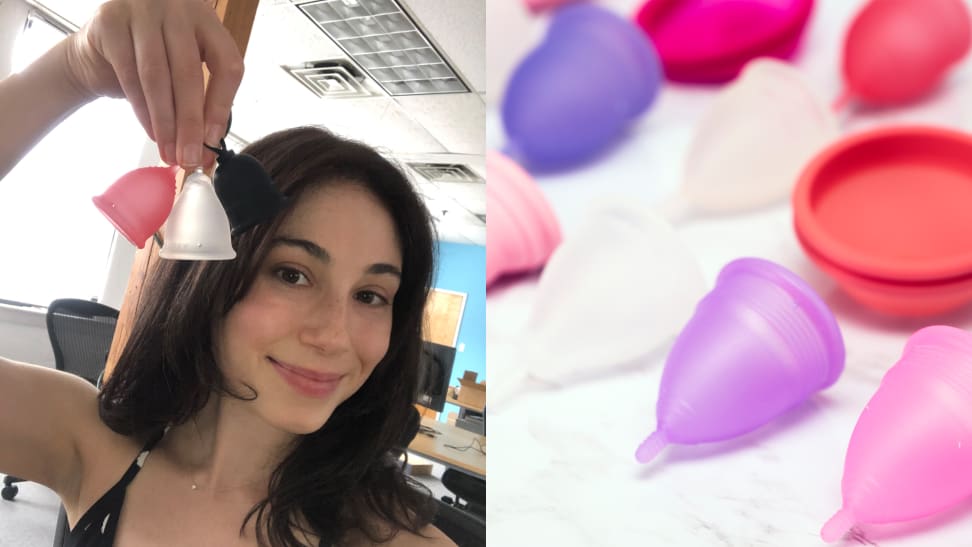 Credit:
Reviewed / Sara Hendricks / Betsey Goldwasser
Credit:
Reviewed / Sara Hendricks / Betsey Goldwasser
Products are chosen independently by our editors. Purchases made through our links may earn us a commission.
To some people, it’s an indecipherable object. If you’re Martin Scorcese, you might think it’s a flagon or an eye cup. But for those in the know, the item in question is a menstrual cup. This reusable bell-shaped period product, usually made of silicone, is inserted into the vagina to collect menstrual fluid—and some period-havers claim it’s a total game changer.
I’d always been curious about cups and drawn to their benefits, such as reduced waste and cost over time when compared with pads and tampons. But I’d never tried one until earlier this year, when I embarked on a comprehensive test of the best menstrual cups, including DivaCup, Saalt, and Lunette. By the end, we had a clear favorite—AllMatters (formally OrganiCup). But I also got a chance to learn how other testers reacted to the product itself and glean these 10 tips that everyone who’s considering a menstrual cup should know.
1. Cups have some pretty great benefits
Menstrual cups have a lot of dedicated fans (more than most menstrual products, anyway). People have different reasons for loving the cup life, but for most, it comes down to three things: time, money, and waste.
Let’s start with time. You can leave most cups in for 12 hours, which is longer than the eight-hour tampon window and, based on my experience, those extra four hours matter. It’s a lot easier for sleeping, especially if you want to hit the snooze button a few times in the morning (guilty). Other devoted users say it’s helpful for long work shifts or school days, travel, and any situation in which you may not have a lot of private time or space.
There’s also a cost-saving aspect. Most cups range in price from about $20 to $40, which feels a lot more expensive for a single item than a box of tampons or pads. For example, 34-pack of Tampax Pearls is $7.24 at Target. But you can get a lot of use out of a single cup—some can last for up to a decade with proper care. If you consider how many of those $7 boxes you might buy over the course of 10 years, that one cup could save you a decent chunk of change.
Finally, cups can help reduce waste. Of course, no single person’s pad and tampon usage is enough to make a landfill overflow or tip the scales of climate change one way or another, but when you use a cup, you’re just using the cup and the little reusable baggie it comes with (and maybe also a reusable pair of period underwear or a few panty liners while you’re getting the hang of it). This eliminates, or at least significantly lessens, the amount of wrappers, applicators, and wads of cotton that go along with pads and tampons. If nothing else, it’ll mean you won’t have to empty your bathroom wastebasket as frequently.
2. Finding your perfect fit can be tricky
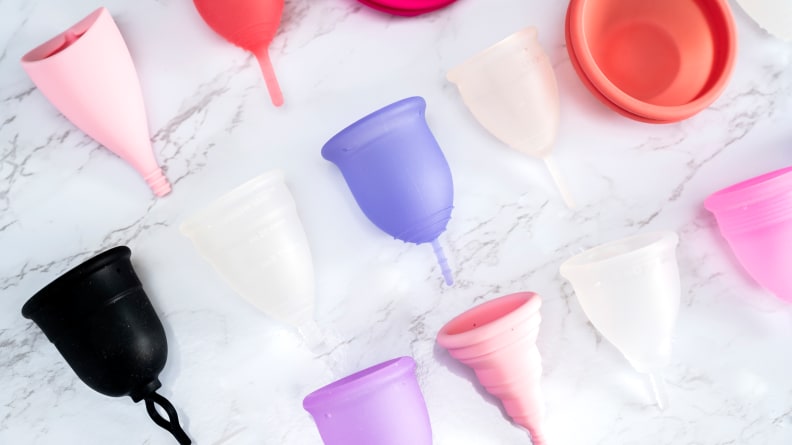
Because there are so many kinds of cups, finding the right cup for you can be a journey.
Figuring out the right size for you is one of the hardest parts of shopping for a cup. Most brands offer two or three different sizes with similar capacities—a “small” cup typically holds about 25 milliliters of fluid and a “large” cup typically holds about 30 milliliters. But the different brands’ cup vary in shape, width, and stem size, all of which have an impact on how it will fit and work based on one’s flow volume, cervix height, vaginal anatomy, and even hand dexterity when inserting and removing the cup.
However, you can make a more accurate estimate if you have an idea of how heavy or light your flow is, how wide or narrow your vaginal canal is, and how high or low your cervix sits. You can find your cervix using your index finger and feeling for something that feels a little firmer than the rest of the vaginal wall, usually described as feeling like the tip of a nose. If that idea isn't your favorite, you can also ask your doctor to let you know if your cervix sits higher or lower than most during a pelvic exam.
You may also take a look at sizing suggestions and quizzes on brands’ sites to give an idea of which cup is best for you. Usually, these rely on the same details (cervix height, type of flow, and activity level) to gauge the right size. Many brands often consider whether or not someone has given birth as a primary size indicator, but based on our testing, this isn’t always that helpful—some people who have had a vaginal birth may still have a lighter flow that calls for a smaller cup, and some people who have never given birth may have a heavier flow that requires a larger cup. It may also be helpful to poke around menstrual cup-themed message boards, such as the r/menstrual cups subreddit, which I did to get some firsthand accounts of different cups.
It’s also a good idea to take a look at the brand’s refund policy, as a safety net if you choose the wrong size. Many, including AllMatters, June Cup, and MeLuna, offer a refund or discount on a new purchase if the cup you bought isn’t working out.
3. The cup’s firmness and stem are two important considerations
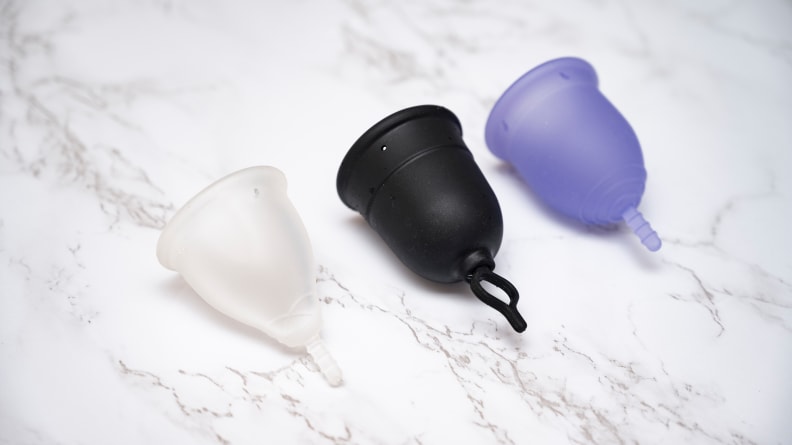
The cup's stem and texture are important.
All the menstrual cups we tested are made out of silicone, but we found a wide variance in the firmness of the material of each cup. Our top pick, AllMatters, is right in the middle, which our testers found allowed it to pop open and stay in place easily without getting uncomfortable. Lunette, DivaCup, and June Cup also have medium-firm textures that should appeal to most.
Some people may prefer softer or firmer cups, depending on their needs. If it’s softer, it may not pop open as easily, but it will be easier to fold and will likely put less pressure on the bladder once inserted. Saalt offers an extra-soft cup in addition to its regular cup that it says is intended for people who experience bladder sensitivity, cramping, or discomfort with standard cups.
On the other hand, a firmer cup will pop open and stay in place more easily (making it a better choice for really active people), but may cause some people discomfort, especially if not situated in the right spot. MeLuna sells a firm cup called “Sport” intended for athletic users, which it says provides a secure seal and resists pelvic compression. One of our testers, a self-described fitness buff, tried it out and no longer had leakage issues from cups that either didn’t pop all the way open or folded in during wear.
Another thing to consider is the cup’s stem. Most have a straight, stick-like peg with ridges, which provide texture to ease finding and grabbing it. However, some stems are on the long side, so you may have to trim it to make sure it works for you. Others, such as Pixie and June Cup, have a ball grip, which could make it easier to find (one tester with long acrylic nails praised the June Cup for this). MeLuna is the only brand we tested that offers three types of stem—a standard ridge, ball grip, and a ring handle, which provides a very tangible thing to grasp. Finally, the brand Flex sells a cup with the most unique stem of the bunch: a pull tab that breaks the suction and allows removal with a single pull, which could make it a great option for people with less hand dexterity.
4. A “cup” isn’t always shaped the way you’d think
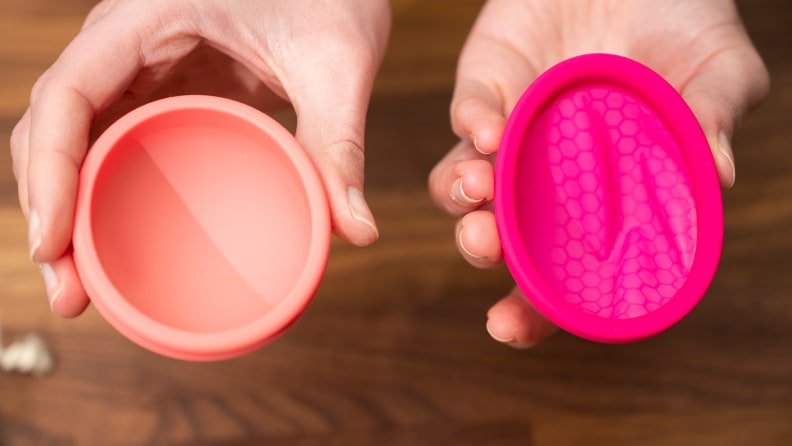
Not all cups are shaped the way you'd think.
A key exception to the “no one size fits all” rule: disc-shaped cups, which come in one size that should fit most. The standard cup model is usually bell-shaped with some sort of stem, a wider base, a rim at the top, and relies on gentle suction to stay in place. Discs are shaped more like a tiny wok about two inches in diameter, with a flexible, rounded center that collects fluid, and do not use suction. They look like the formerly popular birth control option known as a diaphragm, though disc cups should not be used for birth control. We tested two disc-shaped cups—Nixit, our favorite of the type, and the Intimina Ziggy, which didn’t fare as well—and will be testing others in the future, including Cora’s new menstrual disc.
These discs have a steeper learning curve than standard cups: Insertion requires squeezing the edges of the disc together, sliding it in and tucking it up and back against the pubic bone, while removal requires untucking it and sliding it out—all without a stem to guide you. However, once testers got the hang of it, most found that the Nixit felt secure and offered one of the highest volume capacities of all the cups we tested. The lack of suction may also make a disc a better option for someone with an IUD, which has the small risk of being dislodged from its string being accidentally tugged.
What’s more, if it’s inserted correctly, you should be able to have penetrative sex with a disc-shaped cup, which isn’t the case with the bell-shaped ones, as the discs sit flatter and are made of more flexible material. We didn’t officially test for this, but if that’s something that appeals to you, there's no harm in giving it a try. (But remember: Menstrual discs are not a stand-in for birth control or STD prevention.)
5. Using a menstrual cup can be messy, especially at first

Using the cup can be messy, but figuring out the folds that work for you can help.
There’s a learning curve with all cups, so putting it in and taking it out may feel kind of, uh, up close and personal when you first start using it. Some people on r/menstrual cups (and a few cup brands) recommend doing a “dry run” with a new cup, or putting it in, going about your day, and taking it out at a time of month that you aren’t on your period—you’ll get to practice using the cup without the “bonus” challenge of actively menstruating. This is safe to do, as long as you take it out within the required timeframe, because cups do not absorb fluid and thus will not cause uncomfortable dryness when you take it out, which can happen if you were to use a tampon when you aren’t on your period.
The key to avoiding bathroom panic upon insertion is figuring out how to fold the cup to make it skinnier in a way that works for you. All the products we tested came with a pamphlet and/or link to an instructional video that explains the different folds you can do and how to remove it. There are also many how-to videos on YouTube for folding, insertion, and removal. Some brands also suggest using a water-based sexual lubricant to make insertion go more smoothly (and Pixie, for one, even comes with a branded packet of the stuff).
To remove a cup, you'll want to locate the stem, pinch the cup at the base to break the suction seal, and take your time to guide it out to help prevent an all-out explosion (sorry). You’ll also want to make sure you have a good grip on it as you’re taking it out so it doesn’t fall in the toilet. You may find removing it in the shower to be helpful—this way, it was easy to tip, rinse out, and clean off without worrying about accidentally dropping it. Regardless, it's important to wash both the cup and your hands with mild soap and rinse well before reinserting.
6. Having a backup plan isn't a bad idea

You may want to use backup—like period underwear—the first few times you wear your cup.
Part of the learning process will, inevitably, bring some user error. You may experience leaks as you learn the best way to insert your cup and make sure it’s fully open, suctioned, and appropriately positioned, and/or figure your size and style preference. Simply getting used to the difference between “collection” and “absorption” could cause some issues, too. When you put in a cup, any residual menstrual fluid in your vagina isn’t sopped up in the same way it would be with a tampon, so it could imake its way out and onto your undies.
Neither of these scenarios will be everyone’s experience—some people find that the cup works just fine for them on the first go with no leakage concerns—but it can’t hurt to have something to supplement with in the form of period underwear, a pad, or pantiliner for at least your first few gos. If you’re going to be in a place where you may not be able to wash your hands, remove, and re-insert your cup with ease—say, a beach or camping trip—backup is a good idea, too, if only for peace of mind.
As you get used to the cup, you’ll figure out how to use it in a way that works for you. For this reason, most brands recommend trying the cup for at least three cycles before chucking it or gunning for a refund.
7. Going to the bathroom might feel weird
Once it’s inserted, you shouldn’t feel the cup when you’re going about your day. But you may notice it when you use the restroom, whether you’re going #1 or #2. Either way, it’s totally safe to use as you go—it’s inserted into the vagina, which doesn’t interfere with either urination or excretion. But some people say the cup creates a feeling of pressure against the bladder or urethra, which could make you feel like you have to pee more frequently or just feel a little different as you pee. (This is where a softer cup, intended for users with bladder sensitivity, may come in handy.)
The cup could also shift a bit if you “bear down” or push, particularly if you’re using a suction-free disc-shaped cup. In that case, just wash your hands, remove and reinsert it (or just reposition it, if you’re able), and wash your hands again.
8. Cups require maintenance

Whether you boil or steam, you'll have to commit to some cup maintenance.
If you want your cup to last as long as the brand claims it will, you need to take care of it. Instructions vary, but most require boiling for at least five minutes before first insertion to sterilize it, rinsing and washing with soap between wears, and boiling when your period is over—and then doing it all over again for your next period.
This may be too much for some people, especially if you share a kitchen with family members or roommates and don’t want to explain exactly what it is you got going on the stove. To solve that issue, you can also buy menstrual cup steaming pod, which can be used instead of boiling and may help streamline that part of the process. And if you’re using the classic stovetop method but worried about the cup getting damaged, you can stick the cup inside a wire whisk and prop it against the side of the pot—this keeps it submerged in the boiling water without touching the bottom.
9. Using cups can be eye-opening
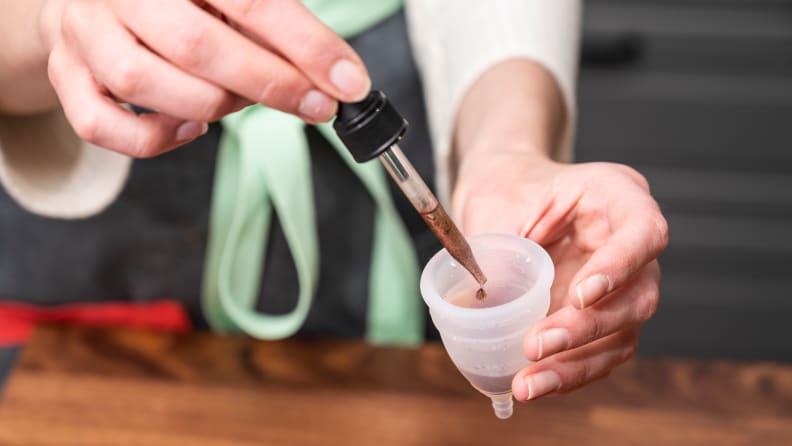
Even if you don't take scientific measurements like we did, it can be instructive to see how much your cup collects.
Menstrual cups can give you a different—and possibly more informative—perspective on your body and cycle than using pads, tampons, and period underwear. For one, I heard from a few people that getting a visual representation of the contents in the cup was surprisingly helpful (some were official testers, some who just use cups, and all with the caveat of “I don’t know if this is too gross, but..."). I agree! Being able to see exactly how much I bled during the time I wore a cup, and how it changed depending on the day, was odd but kind of cool.
What’s more, to use a cup—and especially when you first start—you may have to become more familiar with your own anatomy than you were before. Even if you don’t measure your own cervix height, you’ll be putting your fingers into your vagina to position the cup and to remove it. If you ask us, that's a good thing—nothing in one's own body should be mysterious or off-limits.
10. You may love it or you may not—and either is OK
Some people are relentless in singing the praises of their menstrual cup—and, for what it’s worth, I fully bought into the hype after my tests. But this might not be the case for everyone. Some testers were converts like me, others liked the cups OK but thought they’d prefer to stick with what they know, and others straight-up hated them. If you give it a try, and wind up somewhere in the “meh” zone, that’s perfectly fine. You don’t have to prove anything with your period routine, so if you give something new a try and find that you like your previous method better, well, now you know for sure.
Give your cup a fair shake—again, most brands recommend trying it for three cycles. But if it’s not for you, well, now you know.
The product experts at Reviewed have all your shopping needs covered. Follow Reviewed on Facebook, Twitter, and Instagram for the latest deals, product reviews, and more.


